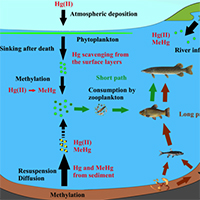Mercury methylation in oxic aquatic macro-environments: a review

Accepted: 27 February 2021
HTML: 106
All claims expressed in this article are solely those of the authors and do not necessarily represent those of their affiliated organizations, or those of the publisher, the editors and the reviewers. Any product that may be evaluated in this article or claim that may be made by its manufacturer is not guaranteed or endorsed by the publisher.
Authors
Mercury methylation in aquatic environments is a key process that incorporates this neurotoxin into the food chain and ultimately the human diet. Mercury methylation is considered to be essentially biotic and mainly driven by sulfate-reducing bacteria present in the bottom sediments in aquatic systems. However, in recent decades, many researchers have shown that this methylation also occurs in oxic layers in conjunction with a high content of particulate organic matter and localized depletion of dissolved oxygen. The goals of this review are to summarize our current understanding of Hg methylation in water columns of both marine and freshwater environments, as well as to highlight knowledge gaps and future research needs. Most of the literature showed that suspended particles (known as marine and lake snow) could be the microenvironment in which Hg methylation could occur across oxic water columns, because they have been recognized as a site of organic matter mineralization and as presenting oxygen gradients around and inside them. To date, the majority of these studies concern marine environments, highlighting the need for more studies in freshwater environments, particularly lacustrine systems. Investigating this new methylmercury production environment is essential for a better understanding of methylmercury incorporation into the trophic chain. In this review, we also propose a model which attempts to highlight the relative importance of a MeHg epilimnetic path over a MeHg benthic-hypolimnetic path, especially in deep lakes. We believe that this model could help to better focus future scientific efforts in limnic environments regarding the MeHg cycle.
Edited by
Diego Fontaneto, CNR-IRSA, Verbania, ItalyHow to Cite

This work is licensed under a Creative Commons Attribution-NonCommercial 4.0 International License.
Similar Articles
- Walter AMBROSETTI, Luigi BARBANTI, Elisabetta A. CARRARA, Mechanisms of hypolimnion erosion in a deep lake (Lago Maggiore, N. Italy) , Journal of Limnology: Vol. 69 No. 1 (2010)
- Kenneth A. SCOTT, Björn WISSEL, John J. GIBSON, Jean S. BIRKS, Chemical characteristics and acid sensitivity of boreal headwater lakes in northwest Saskatchewan , Journal of Limnology: Vol. 69 No. s1 (2010): Impacts of sulphur and nitrogen deposition in western Canada
- Johan C. Varekamp, Lake contamination models… , Journal of Limnology: Vol. 64 No. 2 (2005)
- Tomasz Mieczan, Microcosm on a bottle: experimental tests on the colonization of plastic and glass substrates in a retention reservoir , Journal of Limnology: Vol. 79 No. 3 (2020)
- Giuseppe MORABITO, Waleed HAMZA, Delio RUGGIU, Carbon assimilation and phytoplankton growth rates across the trophic spectrum: an application of the chlorophyll labelling technique , Journal of Limnology: Vol. 63 No. 1 (2004)
- David Glen GEORGE, Margaret Anne HURLEY, Using a continuous function for residence time to quantify the impact of climate change on the dynamics of thermally stratified lakes , Journal of Limnology: Vol. 62 No. s1 (2003): Residence Time in Lakes: Science, Management, Education
- Stephan HÜLSMANN, The combined effect of bottom-up and top-down factors on life history and reproduction of Daphnia in the field: is a strategic dilemma underlying population declines? , Journal of Limnology: Vol. 70 No. 2 (2011)
- Nicola SECHI, Fatima FIOCCA, Antonietta SANNIO, Antonella LUGLIÈ, Santa Giusta Lagoon (Sardinia): phytoplankton and nutrients before and after waste water diversion , Journal of Limnology: Vol. 60 No. 2 (2001)
- Jan SYCHRA, Zdeněk ADÁMEK, The impact of sediment removal on the aquatic macroinvertebrate assemblage in a fishpond littoral zone , Journal of Limnology: Vol. 70 No. 1 (2011)
- Uwe SELIG, Manfred MICHALIK, Thomas HÜBENER, Assessing P status and trophic level of two lakes by speciation of particulate phosphorus forms , Journal of Limnology: Vol. 65 No. 1 (2006)
<< < 77 78 79 80 81 82 83 84 85 86 > >>
You may also start an advanced similarity search for this article.
-
Juanjo RodríguezFrontiers in Marine Science : 2023
-
Thibaut Cossart, Javier Garcia-Calleja, João P. Santos, Elaheh Lotfi Kalahroodi, Isabelle A. M. Worms, Zoyne Pedrero, David Amouroux, Vera I. Slaveykova, Kevin WilkinsonEnvironmental Chemistry : 2022
-
Eric Capo, Claudia Cosio, Elena Gascón Díez, Jean-Luc Loizeau, Elsa Mendes, Thierry Adatte, Sören Franzenburg, Andrea G. BravoWater Research : 2023
-
Laura Marziali, Roberta Piscia, Lucia Valsecchi, Claudio Roscioli, Marina MancaWater : 2022
-
Laura Balzer, Carluvy Baptista-Salazar, Sofi Jonsson, Harald BiesterBiogeosciences : 2023
-
Diva Scuvée, Marisol Goñi-Urriza, Claire Gassie, Bahia Khalfaoui-Hassani, Rémy GuyoneaudMicrobiological Research : 2023
-
María del Carmen Diéguez, Marina Arcagni, Andrea Rizzo, Soledad Pérez Catán, Carolina Soto Cárdenas, Milena Horvat, Sergio Ribeiro GuevaraNatural and Social Sciences of Patagonia : 2022
-
Vincent Noël, Kristin Boye, Hannah R. Naughton, Emily M. Lacroix, Meret Aeppli, Naresh Kumar, Scott Fendorf, Samuel M. WebbFrontiers in Environmental Chemistry : 2024
-
Daniel González-Reguero, Marina Robas-Mora, Agustín Probanza Lobo, Pedro Antonio Jiménez GómezWorld Journal of Microbiology and Biotechnology : 2023

 https://doi.org/10.4081/jlimnol.2021.2007
https://doi.org/10.4081/jlimnol.2021.2007





